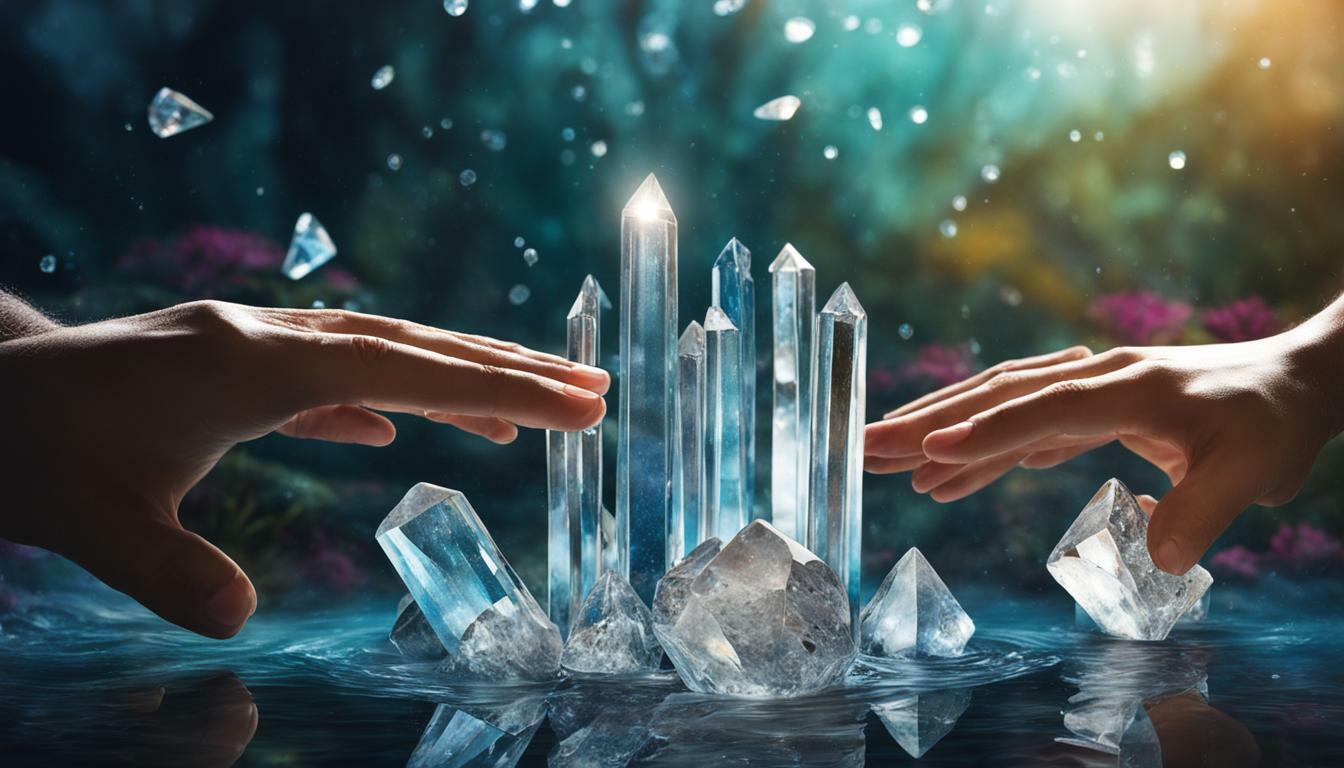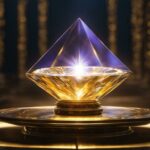When it comes to cleansing and charging crystals with water, it is important to know which crystals are safe to put in water and which ones are not. Crystals that should not be submerged in water include Selenite, Calcite, Honey Calcite, Hematite, Fluorite, Sodalite, Lepidolite, Angelite, Apatite, Malachite, Labradorite, Celestite, Pyrite, Chrysocolla, Opal, and Jade. These crystals may dissolve, break apart, rust, or lose their shine when exposed to water. On the other hand, crystals that can be put in water for cleansing and charging include Clear Quartz, Amethyst, Smoky Quartz, Rose Quartz, Citrine, Snow Quartz, Agate, Aventurine, Jasper, Tiger’s Eye, Amber (with caution), and Jet Stone (with caution). It is always advisable to research the specific properties and hardness of your crystals before using water for cleansing or charging.
Key Takeaways
- It is important to know which crystals are safe to put in water and which ones are not.
- Crystals that should not be submerged in water include Selenite, Calcite, Honey Calcite, Hematite, Fluorite, Sodalite, Lepidolite, Angelite, Apatite, Malachite, Labradorite, Celestite, Pyrite, Chrysocolla, Opal, and Jade.
- These crystals may dissolve, break apart, rust, or lose their shine when exposed to water.
- Crystals that can be put in water for cleansing and charging include Clear Quartz, Amethyst, Smoky Quartz, Rose Quartz, Citrine, Snow Quartz, Agate, Aventurine, Jasper, Tiger’s Eye, Amber (with caution), and Jet Stone (with caution).
- Always research the specific properties and hardness of your crystals before using water for cleansing or charging.
Crystals That Should Not Be Submerged in Water
When it comes to cleansing and charging crystals, water can be a powerful tool. However, not all crystals can safely be put in water. It is important to know which crystals are not water-friendly to avoid damage or unwanted reactions. Crystals that dissolve in water, react with water, or are generally not water-friendly should be kept away from any water-based cleansing or charging methods. These crystals include:
| Crystals | Reasons |
|---|---|
| Selenite | Water can cause it to break down and lose its structure. |
| Calcite | It is sensitive to water and can easily dissolve, leading to shape alteration. |
| Honey Calcite | Similar to Calcite, it can dissolve and lose its natural form. |
| Hematite | Water can cause it to rust or lose its metallic luster. |
| Fluorite | It is susceptible to cracking or breaking when in contact with water. |
| Sodalite | Water can cause it to fade, losing its vibrant blue color. |
Other crystals that should not be submerged in water include Lepidolite, Angelite, Apatite, Malachite, Labradorite, Celestite, Pyrite, Chrysocolla, Opal, and Jade. These crystals have specific characteristics or properties that make them vulnerable to water damage.
On the other hand, there are crystals that can safely be put in water for cleansing and charging purposes. These crystals include Clear Quartz, Amethyst, Smoky Quartz, Rose Quartz, Citrine, Snow Quartz, Agate, Aventurine, Jasper, Tiger’s Eye, Amber (with caution), and Jet Stone (with caution). However, even with these crystals, it is always advisable to research their specific properties and hardness before using water. This will ensure that you protect and care for your crystals in the best possible way.
Remember, knowing which crystals are safe and not safe to put in water is essential for maintaining the integrity and beauty of your crystal collection. By handling your crystals with care and consideration, you can enjoy their positive energy for years to come.
Selenite, Calcite, and Honey Calcite
When it comes to working with crystals, it’s essential to understand which ones are safe to put in water and which should be kept dry. Selenite, Calcite, and Honey Calcite are three crystals that fall into the category of water-sensitive crystals.
Selenite is a delicate crystal that should not be submerged in water. It has a soft composition and can dissolve or break apart when exposed to moisture. In addition, prolonged water exposure can cause Selenite to lose its natural sheen and transparency. To cleanse or charge your Selenite crystal, consider using alternative methods such as moonlight or sound vibrations.
Calcite and Honey Calcite are also crystals that should be kept away from water. While they are relatively harder than Selenite, they can still react with water, leading to changes in color or texture. Calcite crystals may become dull or develop a powdery residue when exposed to moisture. It is best to use dry methods like smudging or visualization to cleanse and charge your Calcite or Honey Calcite crystals.
| Crystal | Water Sensitivity |
|---|---|
| Selenite | High sensitivity – Do not put in water |
| Calcite | Medium sensitivity – Avoid water exposure |
| Honey Calcite | Medium sensitivity – Avoid water exposure |
Remember, it is always important to research the specific properties and hardness of your crystals before using water for cleansing or charging. By understanding the water sensitivity of crystals like Selenite, Calcite, and Honey Calcite, you can ensure the longevity and preservation of their natural beauty.
Hematite, Fluorite, and Sodalite – Crystals That Should Not Be Submerged in Water
When it comes to the world of crystals, it’s important to know which ones are safe to put in water and which ones are not. While water can be a powerful tool for cleansing and charging certain crystals, there are others that should never be submerged in water. Hematite, Fluorite, and Sodalite are three such crystals that can be sensitive to water and may experience damage or changes when exposed to it.
Hematite, a beautiful metallic crystal known for its grounding properties, should be kept dry to maintain its integrity. When in contact with water, Hematite may rust or lose its shine, diminishing its energetic qualities. Similarly, Fluorite, a stunning rainbow-colored crystal, can be adversely affected by water. This delicate crystal can dissolve or break apart when submerged, resulting in a loss of its vibrant hues and unique patterns.
Sodalite, a deep blue crystal with white veins, is another crystal that is not water-friendly. When exposed to water, Sodalite may become dull or lose its luster. It’s important to handle Sodalite with care and avoid immersing it in water to preserve its natural beauty and energetic properties.
| Crystal | Water Sensitivity |
|---|---|
| Hematite | Can rust or lose shine |
| Fluorite | Dissolves or breaks apart |
| Sodalite | Becomes dull or loses luster |
It’s always advisable to research the specific properties and hardness of your crystals before using water for cleansing or charging. Knowing which crystals to avoid submerging in water can help you maintain the beauty and energetic qualities of your crystal collection.
Lepidolite, Angelite, and Apatite: Crystals That Should Not Be Exposed to Water
When it comes to working with crystals, it is important to know which ones are safe to put in water and which ones are not. Lepidolite, Angelite, and Apatite are three crystals that should never be submerged in water. These beautiful stones possess unique properties that make them susceptible to damage when exposed to moisture.
Lepidolite, known for its calming energy and soothing vibrations, is a delicate crystal that can easily be affected by water. It contains soft minerals that can dissolve or break down when immersed in liquids. To preserve its beauty and energetic qualities, it is best to keep lepidolite dry and cleanse it using alternative methods, such as smudging or placing it in a bed of salt.
Angelite, a stone of peace and tranquility, is also sensitive to water. This crystal has a porous nature, which means it can absorb liquids and lose its original form and color. Exposing angelite to water may cause it to become brittle or discolored. To maintain its integrity, it is recommended to use dry methods of cleansing, such as sound or sunlight.
Apatite, a crystal that enhances communication and spiritual growth, is another precious stone that should not come into contact with water. Apatite has a relatively low hardness, making it prone to scratches and erosion when exposed to liquids. To keep your apatite crystal in optimal condition, it is best to cleanse it using dry methods like visualization or burying it in a bed of cleansing herbs.
| Crystal | Water Sensitivity |
|---|---|
| Lepidolite | High |
| Angelite | High |
| Apatite | Medium |
Remember, each crystal has its own unique properties and vulnerabilities. It is essential to research and understand the specific needs of your crystals before exposing them to water. By taking proper care of your crystals, you can ensure their longevity and continue to benefit from their energy and healing properties.
Malachite, Labradorite, and Celestite: Crystals Susceptible to Water Damage
When it comes to cleansing and charging your crystals, it’s important to know which ones are safe to put in water and which ones are not. While water is often used as a cleansing agent, certain crystals can be negatively affected when exposed to it. Malachite, Labradorite, and Celestite are three crystals that should not be submerged in water due to their water sensitivity.
Malachite, with its vibrant green color and beautiful patterns, is known for its softness and vulnerability to water damage. When exposed to water, Malachite can easily lose its luster and develop a dull appearance. It is best to cleanse this crystal using dry methods, such as smudging or placing it on a bed of sea salt.
Labradorite, with its captivating iridescent flashes of color, is another crystal that should be kept away from water. This unique stone is highly susceptible to cracks and fractures when exposed to water. To maintain its integrity, it’s recommended to cleanse Labradorite using other methods, such as moonlight or sound cleansing.
Celestite, with its serene blue hues, is a delicate crystal that should not be subjected to water. When Celestite comes into contact with water, it can dissolve or lose its clarity. To cleanse this crystal, it’s best to use dry methods like sunlight or smudging.
| Crystal | Water Sensitivity |
|---|---|
| Malachite | High |
| Labradorite | High |
| Celestite | High |
Remember, it’s crucial to research the specific properties and hardness of your crystals before using water for cleansing or charging. While Malachite, Labradorite, and Celestite are water-sensitive, there are many other crystals that can safely be put in water for these purposes. Always take the necessary precautions to preserve the beauty and energy of your crystals.
Section 7: Pyrite, Chrysocolla, Opal, and Jade
When it comes to water exposure, caution should be exercised with crystals like Pyrite, Chrysocolla, Opal, and Jade. These crystals are known to be water-sensitive and can undergo potential damage or changes when submerged in water.
Pyrite, also known as Fool’s Gold, is a popular crystal due to its metallic luster. However, it is prone to oxidation and can become discolored or even disintegrate when exposed to water. To preserve its beauty and integrity, it is best to keep Pyrite away from water.
Chrysocolla, a vibrant blue-green crystal, is highly porous and can easily absorb water. This absorption can cause the crystal to become brittle or break apart. To maintain its stability and avoid water damage, it is recommended to keep Chrysocolla dry.
Opal, with its mesmerizing play of colors, is a delicate and porous crystal. It is highly sensitive to changes in temperature and humidity, which can cause it to crack or lose its iridescence when in contact with water. It is advisable to handle Opal with care and refrain from exposing it to water.
Jade, renowned for its beauty and healing properties, is a durable crystal. However, prolonged exposure to water can lead to internal cracks or fissures, compromising its integrity. To preserve the quality of Jade, it is advisable to keep it dry and avoid submerging it in water.
In conclusion, Pyrite, Chrysocolla, Opal, and Jade should not be put in water due to their water-sensitive nature. To ensure the longevity of these crystals, it is important to handle them with care and protect them from water exposure. Remember to research the specific properties of your crystals before using water for cleansing or charging purposes.
Table: Crystals that Should Not Be Put in Water
| Crystal | Water Sensitivity |
|---|---|
| Pyrite | Very sensitive, can oxidize and disintegrate |
| Chrysocolla | Highly porous, can become brittle or break apart |
| Opal | Delicate, can crack or lose iridescence |
| Jade | Durable but can develop cracks or fissures |
Remember, knowing which crystals should not be put in water is crucial to prevent potential damage. By taking proper care of your crystals, you can enjoy their beauty and energy for years to come.
Crystals That Can Be Put in Water for Cleansing and Charging
When it comes to cleansing and charging crystals with water, it is important to know which crystals are safe to put in water and which ones are not. Certain crystals are sensitive to water and can be damaged or undergo changes when submerged. However, there are also crystals that can safely be put in water for cleansing and charging purposes.
Crystals to avoid putting in water include Selenite, Calcite, Honey Calcite, Hematite, Fluorite, Sodalite, Lepidolite, Angelite, Apatite, Malachite, Labradorite, Celestite, Pyrite, Chrysocolla, Opal, and Jade. These crystals have properties and characteristics that make them susceptible to damage when exposed to water. They may dissolve, break apart, rust, or lose their shine, rendering them less effective or even unusable.
On the other hand, there are crystals that can be safely placed in water for cleansing and charging. These include Clear Quartz, Amethyst, Smoky Quartz, Rose Quartz, Citrine, Snow Quartz, Agate, Aventurine, Jasper, Tiger’s Eye, Amber (with caution), and Jet Stone (with caution). These crystals are water-friendly and can benefit from the purifying and energizing properties of water without risk of damage.
Before using water for cleansing or charging, it is always advisable to research the specific properties and hardness of your crystals. Remember that some crystals, even if generally considered safe for water exposure, may have inclusions or vulnerabilities that make them less suitable for prolonged water contact. By being knowledgeable and mindful, you can ensure the best care and maintenance for your crystals, allowing them to continue benefiting you energetically for years to come.
| Crystals to Avoid Putting in Water | Crystals That Can Be Put in Water for Cleansing and Charging |
|---|---|
| Selenite Calcite Honey Calcite Hematite Fluorite Sodalite Lepidolite Angelite Apatite Malachite Labradorite Celestite Pyrite Chrysocolla Opal Jade |
Clear Quartz Amethyst Smoky Quartz Rose Quartz Citrine Snow Quartz Agate Aventurine Jasper Tiger’s Eye Amber (with caution) Jet Stone (with caution) |
Conclusion
When it comes to cleansing and charging crystals with water, it’s crucial to know which ones are safe to put in water and which ones should be avoided. Submerging certain crystals in water can lead to damage such as dissolution, breakage, rusting, or loss of shine. Therefore, it’s important to be aware of the crystals that are not water-friendly.
Crystals that should not be submerged in water include Selenite, Calcite, Honey Calcite, Hematite, Fluorite, Sodalite, Lepidolite, Angelite, Apatite, Malachite, Labradorite, Celestite, Pyrite, Chrysocolla, Opal, and Jade. These crystals have specific properties that make them susceptible to water damage.
On the other hand, there are crystals that can safely be put in water for cleansing and charging purposes. Crystals such as Clear Quartz, Amethyst, Smoky Quartz, Rose Quartz, Citrine, Snow Quartz, Agate, Aventurine, Jasper, Tiger’s Eye, Amber (with caution), and Jet Stone (with caution) can withstand water exposure without any significant harm. However, it’s always advisable to research the specific properties and hardness of your crystals before using water for cleansing or charging.
By understanding which crystals are water-friendly and which ones are not, you can take better care of your crystal collection and avoid any potential damage. So, before using water for any crystal-related practices, make sure to do your due diligence and keep your crystals safe and beautiful.
Can I Use Crystals to Help with Period Cramps?
Using crystals for natural relief for period cramps has gained popularity among some individuals. Supporters claim that crystals such as rose quartz and amethyst can assist with pain reduction and relaxation. However, scientific evidence supporting these claims is limited. It’s important to consult healthcare professionals for reliable advice and explore various methods for finding relief from period cramps.
FAQ
What crystals should not be put in water?
Crystals that should not be submerged in water include Selenite, Calcite, Honey Calcite, Hematite, Fluorite, Sodalite, Lepidolite, Angelite, Apatite, Malachite, Labradorite, Celestite, Pyrite, Chrysocolla, Opal, and Jade.
Why should these crystals not be submerged in water?
These crystals may dissolve, break apart, rust, or lose their shine when exposed to water.
Which crystals can be put in water for cleansing and charging?
Crystals that can be put in water for cleansing and charging include Clear Quartz, Amethyst, Smoky Quartz, Rose Quartz, Citrine, Snow Quartz, Agate, Aventurine, Jasper, Tiger’s Eye, Amber (with caution), and Jet Stone (with caution).
Is it important to research the properties and hardness of crystals before using water for cleansing or charging?
Yes, it is always advisable to research the specific properties and hardness of your crystals before using water for cleansing or charging.








